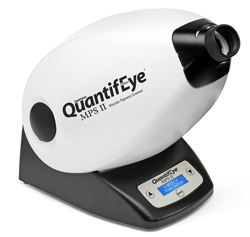MPOD Measurement Approved for Category III CPT Code
Posted by amess on Jul 2nd 2018
There are many different levels and categories of medical instrumentation. As each new piece of equipment undergoes evaluation and becomes more common, the American Medical Association (AMA) assigns codes depending on where the machinery is in its research and validity journey. EyePromise® is proud to announce that macular pigment optical density (MPOD) measurement by heterochromatic flicker photometry (HFP) has earned the AMA’s Category III CPT code, and it's listed under code 0506T.
What is HFP?
Heterochromatic flicker photometry is a noninvasive diagnostic test to measure MPOD. The macular pigment is made up of zeaxanthin and lutein, and these carotenoids protect the retina and shield it from harm caused by damaging light waves known as short-wavelength, high-energy, visible blue light. Damage from blue light has been linked to the development of age-related eye health concerns, and the National Eye Institute (NEI) expects a 50% increase in these concerns in the US by 2020.
How It Works
MPOD measurement is most commonly performed in ophthalmology and optometry offices. With the best results achieved in a quiet, darkened room, the patient views a small circular stimulus that alternates between a blue light which is supposed to be absorbed and a green light that is not. The patient sees a flicker the moment the macular pigment is saturated by the blue light and presses a response button on the device. An MPOD measurement is generated depending on how long it takes the patients to see the flicker. The physician then interprets and explains the results to the patient.
Who Should Be Tested?
Patients at risk for developing of age-related eye health concerns are candidates for HFP, but it's recommended to start testing patients over 21 to detect any eye health changes early. MPOD measurements are an objective tool for estimating this risk, and MPOD can improve with nutraceuticals and changes in the diet to include foods rich in lutein and zeaxanthin. Central measurement on one eye is typically the only measurement necessary to get an understanding of macular pigment health.
Long-Term MPOD Measurement
Measurement over time can assess whether dietary changes and/or supplementation with the macular carotenoids start to rebuild the macular pigment and diminish the harmful effect of blue light. Any changes, whether they indicate improvement or decline, provide clinicians with another data point to assess a patient’s risk level for developing eye health concerns. While this assessment emits blue light, it is not in large enough amounts to cause damage to patients’ eyes. Periodic testing in at-risk patients with high oxidative stress (smokers, heavy drinkers, and those with low fruit and vegetable intake) can help identify, evaluate, and manage early signs of age-related eye health concerns.
What is a Category III CPT Code?
Category III CPT codes are used for data collection and tracking for products or services involved in planned or ongoing research to help researchers substantiate widespread usage and efficacy. Simply put, this critical examination is gaining traction in the clinical setting, and the AMA wants to be able to track its progress. It does not receive paid reimbursement or have a Medicare-allowed amount associated with it, so patients are financially responsible for tests as long as it’s agreed upon prior to testing. While the examination is not mandatory, the benefits of the exam far outweigh the minimal cost. Once the patient accepts the test, there are several different financial waivers that are available, depending on insurance. These waivers are listed in the FAQs.
Meeting the Requirements for Code 0506T
For MPOD measurement, the code is effective as of July 1st, 2018. In order for an eye care professional to fully meet the code requirements, they must interpret and report on the testing they complete. A quick “abnormal” notation is not enough. Records should include:
- Order for the test with medical rationale
- Date of the test
- The reliability of the test
- Test findings (i.e., MPOD measurement)
- Comparison with prior tests (if applicable)
- A diagnosis (if possible)
- The impact on treatment and prognosis (i.e. treatment with a diet rich in antioxidants and/or antioxidant supplements)
- Physician signature
How Can I Measure MPOD?
 EyePromise offers HFP MPOD measurement technology with the QuantifEye® MPS II. Proven to have 97% repeatability, the instrument takes about 2-3 minutes per patient and includes intuitive technology with icon-driven menus and enhanced reporting for staff members and patients. Studies continue to show the accuracy and reliability of the QuantifEye MPS II, including:
EyePromise offers HFP MPOD measurement technology with the QuantifEye® MPS II. Proven to have 97% repeatability, the instrument takes about 2-3 minutes per patient and includes intuitive technology with icon-driven menus and enhanced reporting for staff members and patients. Studies continue to show the accuracy and reliability of the QuantifEye MPS II, including:
- Case Report of Dietary Supplements Improving Macular Pigment and Visual Function (Herman, Kleiner-Goudey, Davis – Advances in Ophthalmology and Visual System: January 2017)
- The Value of Measurement of Macular Carotenoid Pigment Optical Densities and Distributions in Age-Related Macular Degeneration (Bernstein, et. al. – Vision Research, 2010)
- Desktop Macular Pigment Optical Density Measurement: A New Approach Based on Heterochromatic Flicker Photometry (Berendschot, et. al. – E, volume 25)

